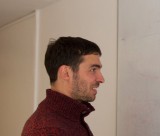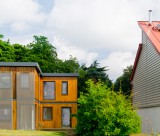The University of Nottingham
 Exchange online
Exchange online
Research Exchange
Research could offer new hope for patients with cardiovascular disease

November 2 2014
New research has shown a protein that controls the growth of new blood vessels could potentially reduce the effects of cardiovascular disease in patients’ legs, including risks of leg ulcers, gangrene, and amputation.
The study led by academics in Boston and involving researchers at The University of Nottingham centred on the role that the signal protein vascular endothelial growth factor (VEGF) plays in peripheral arterial disease (PAD).
It found that, unlike other people, patients with symptomatic arterial disease did not produce the correct form of VEGF needed to stimulate new blood vessel growth in their leg, placing them at greater risk of losing the limb.
PAD is one of the most common causes of leg amputation. The femoral artery becomes blocked by a build-up of fatty deposits leading to ischemia — or loss of blood flow. In the most serious cases, leg tissue begins to die, known as gangrene, and the lower leg may need to be removed.
The new research, involving Professor David Bates, in The University of Nottingham’s Cancer Biology Unit and published in the leading academic journal Nature Medicine, discovered that some patients may be at a higher risk of amputation because they produce the type of VEGF that blocks blood vessel growth rather than stimulating it.
Professor Bates said: “PAD is a fairly common disease but not all people who develop it will exhibit symptoms. If you take a large group of 70 year olds and study the blood vessels in their leg after death then quite a high percentage will show evidence of having had a blockage. However, in many cases other blood vessels will have grown around the blocked artery to compensate.
“In many patients, and particularly those with diabetes, we don’t see that blood vessel re-growth and for those patients PAD is difficult to treat, sometimes leading to amputation.”
VEGF comes in two forms — proangiogenic VEGF (VEGF-Aa) which stimulates the growth of new blood vessels and antiangiogenic VEGF (VEGF-Ab) which suppresses new vascular development and was discovered by Professor Bates over 10 years ago.
The researchers found that in people with PAD, although VEGF is triggered, it does not form new blood vessels to offset the effects of the arterial blockage. Instead it was activating white blood cells to produce the wrong type of VEGF — the antiangiogenic form.
The study also showed that the effect can be suppressed in obese and diabetic mice in the laboratory by giving them an antibody to the anti-angiogenic VEGF and the researchers are now set to develop a similar antibody for use in humans.
The antibody could be used to treat patients with PAD over the course of several months until new blood vessels in their legs have grown back.
High levels of the proangiogenic form of VEGF are also potentially associated with increased pain, tumour growth and kidney disease. For this reason, the researchers are investigating whether they can switch the production of VEGF from its antiangiogenic form to its proangiogenic form directly within the white blood cell itself while not affecting its expression in other areas of the body.
The work was funded by the National institutes of Health in the USA and the British Heart Foundation in the UK.
Dr Shannon Amoils, Senior Research Adviser at the BHF, said: “This important research, part funded by BHF, has revealed a possible new target for treatment of people with peripheral arterial disease, VEGF-Ab. This target could potentially be manipulated to help improve blood supply to an oxygen starved limb, lowering the chances of amputation for people with this condition.”
The research was led by Ken Walsh at Boston University and also involved Professor David Bates.
Tags: antiangiogenic VEGF, British Heart Foundation, Cancer Biology Unit, cardiovascular disease, Dr Shannon Amoils, leg amputation, National institutes of Health, Nature Medicine, new blood vessel growth, peripheral arterial disease, proangiogenic VEGF, Professor David Bates, research, signal protein vascular endothelial growth factor, symptomatic arterial disease
Leave a Reply
Other

Top prize for quantum physicist
A University of Nottingham physicist has won a prestigious medal from the Institute of Physics for […]

Zero carbon HOUSE designed and built by students comes home
Design and construct a low cost, zero carbon, family starter home, transport it to Spain, build […]